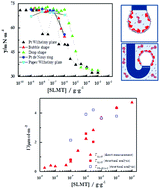当前位置:
X-MOL 学术
›
Phys. Chem. Chem. Phys.
›
论文详情
Our official English website, www.x-mol.net, welcomes your feedback! (Note: you will need to create a separate account there.)
Towards understanding the behavior of polyelectrolyte–surfactant mixtures at the water/vapor interface closer to technologically-relevant conditions
Physical Chemistry Chemical Physics ( IF 3.3 ) Pub Date : 2017-12-18 00:00:00 , DOI: 10.1039/c7cp05528e Sara Llamas 1, 2, 3 , Laura Fernández-Peña 1, 2, 3 , Andrew Akanno 1, 2, 2, 3, 4 , Eduardo Guzmán 1, 2, 2, 3, 4 , Víctor Ortega 2, 3, 4 , Francisco Ortega 1, 2, 2, 3, 4 , Aurelio G. Csaky 2, 3, 4 , Richard A. Campbell 5, 6, 7 , Ramón G. Rubio 1, 2, 2, 3, 4
Physical Chemistry Chemical Physics ( IF 3.3 ) Pub Date : 2017-12-18 00:00:00 , DOI: 10.1039/c7cp05528e Sara Llamas 1, 2, 3 , Laura Fernández-Peña 1, 2, 3 , Andrew Akanno 1, 2, 2, 3, 4 , Eduardo Guzmán 1, 2, 2, 3, 4 , Víctor Ortega 2, 3, 4 , Francisco Ortega 1, 2, 2, 3, 4 , Aurelio G. Csaky 2, 3, 4 , Richard A. Campbell 5, 6, 7 , Ramón G. Rubio 1, 2, 2, 3, 4
Affiliation

|
Polyelectrolyte–surfactant mixtures and their interactions with fluid interfaces are an important research field due to their use in technological applications. Most of the existing knowledge on these systems is based on models in which the polyelectrolyte concentration is around 50 times lower than that used in commercial formulations. The present work marks a step to close the gap on the understanding of their behavior under more practically-relevant conditions. The adsorption of concentrated mixtures of poly(diallyldimethyl-ammonium) chloride and sodium N-lauroyl-N-methyltaurate at the water/vapor interface with a crude mixing protocol has been studied by different surface tension techniques, Brewster angle microscopy, neutron reflectometry, and several bulk characterization techniques. Kinetically-trapped aggregates formed during mixing influence the interfacial morphology of mixtures produced in the equilibrium one-phase region, yet fluctuations in the surface tension isotherm result depending on the tensiometric technique applied. At low bulk surfactant concentrations, the free surfactant concentration is very low, and the interfacial composition matches the trend of the bulk complexes, which is a behavior that has not been observed in studies on more dilute mixtures. Nevertheless, a transition to synergistic co-adsorption of complexes and free surfactant is observed at the higher bulk surfactant concentrations studied. This transition appears to be a special feature of these more concentrated mixtures, which deserves attention in future studies of systems with additional components.
中文翻译:

试图了解更接近技术相关条件的水/蒸汽界面处的聚电解质-表面活性剂混合物的行为
聚电解质-表面活性剂混合物及其与流体界面的相互作用由于其在技术应用中的使用而成为重要的研究领域。这些系统上的大多数现有知识都是基于模型,其中聚电解质的浓度比市售配方中所用的浓度低约50倍。目前的工作标志着缩小在更实际相关条件下对他们的行为的理解上的差距的一步。聚(二烯丙基二甲基氯化铵)和N-月桂酰-N的浓混合物的吸附通过不同的表面张力技术,Brewster角显微镜,中子反射法和几种体积表征技术研究了在水/蒸汽界面处具有粗混合方案的甲基牛磺酸盐。混合过程中形成的被动力学捕获的聚集体会影响在平衡一相区域中生成的混合物的界面形态,但表面张力等温线的波动仍取决于所采用的张力技术。在较低的表面活性剂浓度下,游离的表面活性剂浓度非常低,界面组成与本体复合物的趋势相符,这是在更稀的混合物的研究中未观察到的行为。尽管如此,在较高的整体表面活性剂浓度下,观察到了络合物和游离表面活性剂向协同共吸附的过渡。这种过渡似乎是这些浓度更高的混合物的一个特殊功能,在以后对带有附加组分的系统的研究中,应引起注意。
更新日期:2017-12-18
中文翻译:

试图了解更接近技术相关条件的水/蒸汽界面处的聚电解质-表面活性剂混合物的行为
聚电解质-表面活性剂混合物及其与流体界面的相互作用由于其在技术应用中的使用而成为重要的研究领域。这些系统上的大多数现有知识都是基于模型,其中聚电解质的浓度比市售配方中所用的浓度低约50倍。目前的工作标志着缩小在更实际相关条件下对他们的行为的理解上的差距的一步。聚(二烯丙基二甲基氯化铵)和N-月桂酰-N的浓混合物的吸附通过不同的表面张力技术,Brewster角显微镜,中子反射法和几种体积表征技术研究了在水/蒸汽界面处具有粗混合方案的甲基牛磺酸盐。混合过程中形成的被动力学捕获的聚集体会影响在平衡一相区域中生成的混合物的界面形态,但表面张力等温线的波动仍取决于所采用的张力技术。在较低的表面活性剂浓度下,游离的表面活性剂浓度非常低,界面组成与本体复合物的趋势相符,这是在更稀的混合物的研究中未观察到的行为。尽管如此,在较高的整体表面活性剂浓度下,观察到了络合物和游离表面活性剂向协同共吸附的过渡。这种过渡似乎是这些浓度更高的混合物的一个特殊功能,在以后对带有附加组分的系统的研究中,应引起注意。



























 京公网安备 11010802027423号
京公网安备 11010802027423号